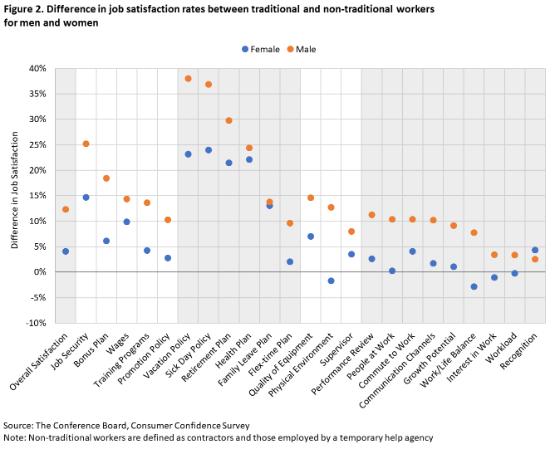Non-Traditional Workers Are Less Satisfied at Work, Especially Men
15 Oct. 2018 | Comments (0)
Attracting and retaining talented workers remains a hot-button issue for businesses everywhere. With the large generation of baby boomers expected to leave the labor force over the next decade, labor shortages will likely worsen before they get better. Combatting this tightening labor market from an employer standpoint could mean hiring more independent contractors, temporary help agency workers, or other non-traditional workers. As talent acquisition and workforce planning departments review these alternative work arrangements, it is important to consider how worker satisfaction might be affected.
Data from The Conference Board Consumer Confidence Survey®(CCS) provides a unique opportunity to compare job satisfaction rates between traditional and non-traditional workers. The monthly CCS measures consumers’ perceptions of current business and employment conditions. In 2016 and 2017, a question was added to identify respondents’ worker status by asking, “Are you currently employed as a contractor or by a temp help agency?” Out of 2,950 responses to this question, 220 answered yes. The entire panel was then asked to assess their level of satisfaction for 24 different job characteristics.
Results show that workers employed through non-traditional arrangements had lower rates of job satisfaction than those that were not, with gaps varying by job characteristic. Shown in Figure 1, non-traditional workers had an 8 percent lower overall job satisfaction rate. Differences were even greater when respondents assessed the economic characteristics and fringe benefits associated with their jobs. Non-traditional workers had over a 26 percent lower satisfaction rate for their job’s vacation and sick day policies, and over a 22 percent lower rate for their job’s health and retirement plans. Job security had a comparably large difference with non-traditional workers having a 20 percent lower satisfaction rate.

Considering the nature of alternative worker arrangements with reduced employer labor costs and simplified means of offboarding, it’s not surprising to see lower satisfaction rates for benefits typically only associated with traditional, permanent jobs. Employer engagement of their non-traditional workers can also be a factor impacting employee satisfaction levels, especially for work environment and communication channels.
Of the 24 job characteristics, not all had significant differences. Recognition, workload, work/life balance, and interest in work had little to no difference in job satisfaction rates between traditional and non-traditional workers (difference of 3% or less).
For male and female workers, job satisfaction differences were not equal. Shown in Figure 2, the gap in job satisfaction rates between traditional and non-traditional workers was smaller for females for 23 of the 24 job characteristics. Male non-traditional workers had a 12 percent lower overall job satisfaction rate than male traditional workers. For female non-traditional workers, the rate was only 4 percent lower. Economic job characteristics and some benefits had the largest gap between men and women. Male non-traditional workers were much less satisfied in their job security, bonus plan, vacation policy, and sick day policy than females. Recognition is the only job characteristic where the satisfaction gap was larger for female workers than for male workers.

Female non-traditional workers even had a higher job satisfaction rate than their traditional counterparts for workload, interest in work, work/life balance, and physical environment (indicated by a negative difference). Apart from family leave and health plans, where differences in job satisfaction between traditional and non-traditional were about equal, much of the dissatisfaction of non-traditional workers appears to have come from men.
Up until now, there doesn’t appear to have been any noticeable growth in employer use of these non-traditional workers. The Contingent Worker Supplement conducted by the Bureau of Labor Statistics indicates no growth over the past two decades in the percentage of workers employed as independent contractors, on-call workers, temp-help agency workers, or contract firm workers. Lower satisfaction rates likely contribute to the lack of growth, with workers perhaps unwilling to engage as a contingent or non-traditional employee. A forthcoming 2018 report by The Conference Board on non-traditional work is set to address the lack of growth and impact alternative work arrangements will have on the U.S. labor market. Hiring workers through alternative arrangements is certainly a viable option for many employers, but satisfaction levels may make it difficult for employers to significantly change their share of non-traditional workers.
-
About the Author:Agron Nicaj
Agron Nicaj is a former Associate Economist with The Conference Board’s Help Wanted OnLine (HWOL)© and Labor Markets programs. He was responsible for the production and analysis of the HWOL…


0 Comment Comment Policy